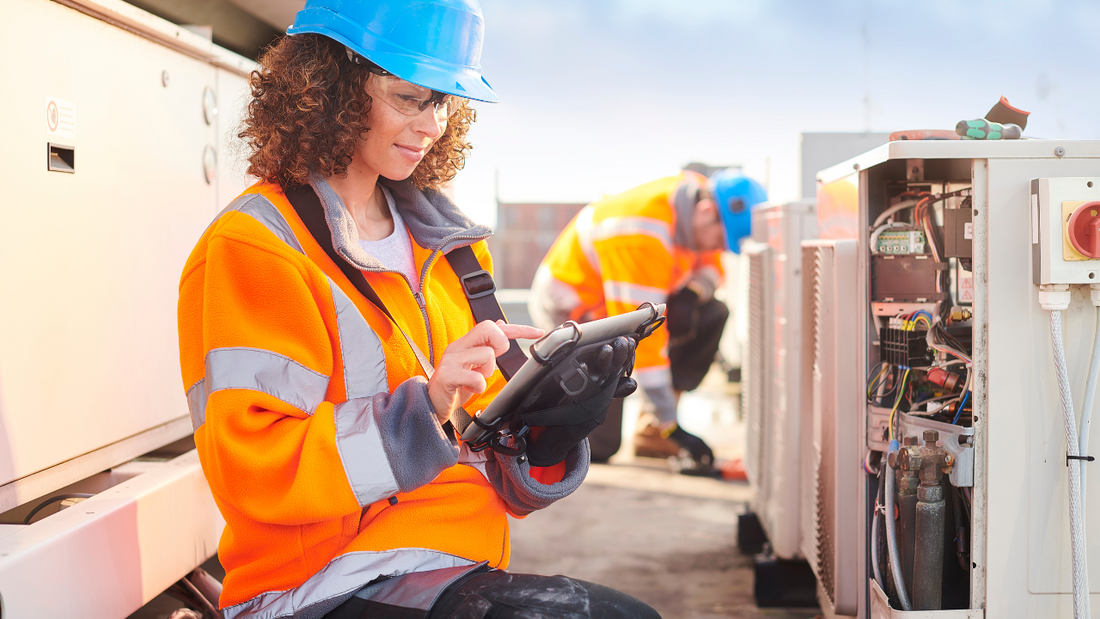
Do You Need an Air Purifier or a Better HVAC Filter?
You’ve noticed the dust piling up, someone in your household has allergies, or you’ve become more aware of air-quality threats like wildfire smoke or indoor pollutants. So you’re asking: should I buy a standalone air purifier, upgrade my HVAC filter, or maybe both?
This isn’t just about comfort. Your home is likely your largest investment. It’s where your family spends most of their time. The air circulating inside affects health, comfort and even long-term property condition. Getting this right matters.
What Your HVAC Filter Really Does
Every home with central heating or cooling uses a filter in the return duct or air handler. But surprise: that filter is primarily there to protect your HVAC system, not to clean air for your benefit. It keeps large particles out of coils and motors, helping the system run. The improved air you breathe is a bonus.
- Typical residential filters: MERV 5-8. These catch large particles like dust, pollen, pet hair.
- They do not reliably capture very small particles (e.g., < 1 micron) such as fine particulate matter, many bacteria, some viruses.
- Worse: if you install a filter that’s too restrictive (higher MERV than your system is designed for), you may reduce airflow and stress your equipment.
So, upgrading your HVAC filter is helpful — but it may not solve all your indoor-air issues.
The Stand-Alone Air Purifier Advantage
A dedicated air purifier takes a different approach. It runs independently of your HVAC system and focuses on removing airborne contaminants within a specific space.
- Most effective purifiers use HEPA filters (High Efficiency Particulate Air) — capturing ~99.7% of particles ≥ 0.3 microns.
- Useful for smaller, targeted rooms: bedroom, home office, kitchen, where you spend significant time or where pollutant exposure is higher.
- Because you can run them continuously, they provide benefit even when the HVAC isn’t actively running.
Why You Might Want Both
Rather than “air purifier or better HVAC filter”, the real solution often is “both”. They serve different but complementary functions:
- HVAC filter = whole-house coverage (when system runs), large air volumes, every room.
- Air purifier = targeted, continuous cleaning in a specific space, filters smaller particles, independent of heating/cooling cycles.
For example: your HVAC system handles baseline airflow and large dust particles; a purifier protects a high-use space (sleeping room) where air quality matters most.
MERV Ratings: What You Need to Know
If you’re upgrading your HVAC filter, understanding MERV ratings is important.
- MERV = Minimum Efficiency Reporting Value. Higher number = better at capturing smaller particles.
- But higher isn’t always better: too high a MERV for your system can reduce airflow, reduce efficiency, even damage equipment.
-
For most homes: a MERV 8–13 pleated filter offers a good balance.
- MERV 8: notable upgrade from basic filter.
- MERV 11/13: captures smaller particles (pet dander, smaller pollen).
- Before installing a high-MERV filter, check with your HVAC contractor or review your system’s specs.
What Recent Research Changes the Conversation
Here are some relevant findings and news you might want to highlight:
- A 2025 study from UConn School of Medicine found that using HEPA air purifiers in homes of adults with elevated blood pressure lowered systolic blood pressure by ~2.8-3 mmHg in one month.
- Another recent review found that though many air-cleaning technologies (HEPA filters, UV systems, ionizers) are marketed for infection control, only a small percentage of studies examine real‐world health outcomes (e.g., fewer illnesses) rather than just particle counts.
- On air purifiers themselves: the National Institute of Standards and Technology (NIST) found some portable air cleaners produce unintended by-products (chemicals, ozone) and recently published a standard test method to measure those emissions.
- Wildfire smoke remains a major concern for indoor air. A global study found over one billion people were exposed to indoor air pollution from wildfires annually.
Recent indoor‑air and wildfire news
- The GuardianToxic wildfire pollution infiltrates homes of 1bn people a year, study findsMay 14, 2025
- The Washington PostWildfire smoke seeps into homes. Global protection would cost billions.May 14, 2025
- TIMECan Air Conditioning Make You Sick?Jun 12, 2025
- People.comScented Wax Melts Create Particles in Indoor Air That 'You Shouldn't Be Breathing In': 'Comparable to Diesel Engines'Feb 17, 2025
What these mean for you as a homeowner:
- Air purifiers aren’t just for dust: they may deliver measurable health benefits in some cases.
- But they’re not magic: some devices may have drawbacks (by-products).
- Upgrading HVAC filtration remains foundational.
- Context matters: where you live (wildfires, pollution) and your health needs (allergies, asthma) affect how much you should invest.
When to Prioritize an HVAC Filter Upgrade
Upgrading your HVAC filter makes sense if:
- Your current filter is a basic fiberglass model (low MERV).
- You want whole-house improvement, equipment protection, and dust reduction.
- Your air quality concern is generalized (dust, moderate allergies) rather than acute (wildfire smoke, heavy pollution).
- Your system is designed for improved filters (consult your HVAC contractor).
Caveats: Upgrading the filter won’t change air when your system is off, and it likely won’t match HEPA-level performance.
When to Consider a Stand-Alone Air Purifier
Consider a purifier if:
- Someone in your household has asthma, allergies, or respiratory sensitivities.
- You live in a region with wildfire smoke or high external pollution.
- You spend significant time in one or two rooms (bedroom, office) and want targeted air-cleaning.
- Your budget allows for device purchase + ongoing filter replacements (and you’ll run it).
The Cost Side of the Equation
Here’s a rough comparison to help homeowners:
- Air purifiers: Initial cost ~$100-$700 depending on size/capacity. Filter replacement every 6-12 months ($20–$100 per replacement)
- HVAC filter upgrade: Upgrading from basic to MERV 10/11 might cost an additional $10–$20 per filter. Changing every 1–3 months, maybe $40-$80 extra per year.
- Strategy: For many homes, moderate HVAC filter upgrade + one or two targeted air purifiers = smart budget allocation.
When It’s Time to Call the HVAC Contractor or Bigger Professionals
If you still have air-quality problems despite upgrades, or you notice:
- Visible mold, strong smells, unexplained dust increases.
- Persistent allergies or respiratory symptoms.
- HVAC system issues: weak airflow, old/dirty ducts, leaks.
Call an HVAC contractor. Upgrading filters or buying purifiers won’t fix mechanical or design issues (e.g., leaky ducts, poor ventilation). That is where your hvac business or service professional comes in. Also from an insurance and property‐risk viewpoint: poorly maintained HVAC systems or hidden mold/leak issues can impact insurability and risk for your home.
Tailoring for Your Region (e.g., California)
Since you're writing for homeowners (and with you being in California via your agency), mention regional factors:
- Wildfire smoke is a recurring issue in many parts of California. Even when indoors, toxic particles get inside homes.
- Coastal vs inland vs mountain homes face different challenges: humidity/mold, agricultural dust, smoke, etc.
- For many CA homes, having at least one quality air purifier becomes more of a necessity than a luxury when smoke days hit.
- Your insurance agency (e.g., your team at Farmers Insurance Young Douglas) can help homeowners understand how these home‐maintenance decisions interact with property protection.
We also support HVAC contractors by helping them secure the best hvac insurance for their trade, check out our guide for HVAC ductwork contractors in California.”
Quick Checklist for Homeowners
- Upgrade your HVAC filter if you’re still using a basic, low-MERV option.
- Confirm your HVAC system can handle a higher-MERV filter by consulting an HVAC contractor.
- If you have allergies, asthma or live in a smoke-prone area, add a HEPA air purifier in your main living spaces or bedroom.
- Monitor ongoing costs (filter replacements, power usage).
- If air quality or system performance still feels off — call the professionals.
- Think about how these actions (filtering, purifying, HVAC maintenance) tie into your home protection and insurance coverage.
For homeowners thinking about best hvac insurance and risk mitigation:
Your HVAC system and indoor-air quality aren’t just comfort features, they’re part of your home’s health, your family’s health, and your home’s value. As an insurance agency, we help homeowners recognize that equipment maintenance, system upgrades and air-quality improvements are part of the story of home protection. A well-maintained HVAC system and smart air-quality approach reduce risk of equipment failure, mold, respiratory problems and insurance claims.
If you’re an HVAC contractor or technician serving California homeowners, we’d love to highlight your work. Get featured on our California HVAC Technicians & Pros page and connect with local homeowners looking for trusted professionals.
